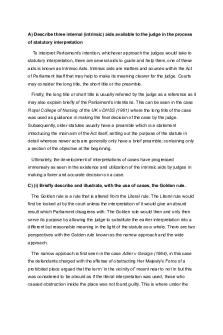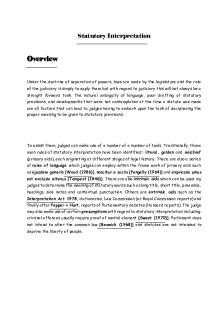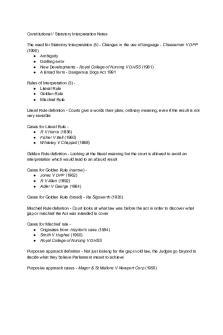Statutory Interpretation PDF

| Title | Statutory Interpretation |
|---|---|
| Course | Bachelor of Business Bachelor of Laws |
| Institution | University of Technology Sydney |
| Pages | 6 |
| File Size | 185.2 KB |
| File Type | |
| Total Downloads | 34 |
| Total Views | 157 |
Summary
70102 Foundations of Law: Statutory Interpretation...
Description
Statutory Interpretation Part A - Locating Legislative Provision (1) Relevant Provision: Section 38S o f the Anti Discrimination Act 1977 1 (2) Amending Act that inserted the provision: Transgender (Anti-Discrimination and Other Acts Amendment) Act 19962 (3) Date of Assent: 19 June 1996 (4) Date of Commencement: 1 October 1996 (5) Research Strategy To locate the I went to NSW Legislation.gov.au then searched for “Transgender” by using the “search in force and repealed” → “exact phrase…”. Scrolled down to find “Division 5 Transgender Vilification” → “38S Transgender Vilification Unlawful” to get the relevant provision which is the Anti Discrimination Act 1977 (s) 38 . Afterwards while keywording “Transgender”, scrolled down to find “Historical Notes” → “table of amending instruments” then continued to fine“1996 → No. 22 → “Transgender (Anti-Discrimination and Other Acts Amendment) Act 1996” to get the Amending Act that inserted the provision. The word “Transgender” is highlighted in orange which opens PDF document → Transgender (Anti-Discrimination and Other Acts Amendment) Act 1996 and shows the Date of Assent (19 June 1996). However, Date of Commencement, was not found so searched in AUSTLII → Databases → New South Wales Regulations As Made → “Transgender (Anti-Discrimination and Other Acts Amendment) Act 1996 – Proclamation re commencement (1996-479) to find the Date of Commencement (1 October 1996).
1 2
Anti Discrimination Act 1977 s 37S Transgender (Anti-Discrimination and Other Acts Amendment) Act 1996
Part B - Interpreting the Provision Cases Cited Stevens v Hancock [2015]3 i s an example of the Civil and Administrative Tribunal of New South Wales recognising the perpetrator unlawfully vilifying a transgender person. For a decade Pindi Stevens, a male to female transgender person, was subjected to discrimination and unlawful vilification against a person on transgender grounds by Troy Hancock. The Tribunal recognised the perpetrator had vilified the aggrieved person and ordered Mr Hancock to “give in” to Mrs Stevens and reside an apologetic letter; failure to comply in 21 days results in paying a sum of $2,000 to Mrs Steven. On the other hand, Barry v Futter [2011]4 is a prime example of the complaint being dismissed as a whole under s.108 (1) (a) 5 of the Anti Discrimination Act 1977 . “Mr” Barry, a female to male transgendered person, was unlawfully vilified against another employee, “Ms” Futter. The Administrative Decision Tribunal recognised that Ms Futter verbally harassed Mr Barry and his relationship to another employee, Mr Bianco; however this was a private conversation but in a public place. The Tribunal recognised that the communication between Mrs Futter and Mr Bianco was not a result of a public act which therefore saw s.38S of the Anti Discrimination Act was not relevant nor constituted as a “transgender vilfication”.
Elements on Unlawfully Vilifying a Transgender person The NSW statutory provision on vilifying a transgender person require crucial pertinent elements to prove discrimination on transgender grounds which are stated in s.38B (1), s.38R a nd s.38S (1) of the Anti Discrimination Act 1977 ( “ADA”). These elements determine and outline the offence when committed. Transgender As defined in s.38A of the Transgender (Anti-Discrimination and Other Acts Amendment) Act 19966, a transgender person is, “the state of a person’s gender identity not matching their 3
Stevens v Hancock [2015] NSWCATAD 126 arry v Futter [2011] NSWADT 205 B 5 Anti Discrimination Act 1977 s 108 (1) (a) 6 Ibid s 38A 4
assigned sex at birth” is also recognised in Part 5A of the Births, Deaths and Marriages Registration Act 19957. Discrimination on Transgender Grounds Under section 38B (1) (a) of the Anti Discrimination Act 1977 a person (the perpetrator) discriminates against another person (the aggrieved person) on transgender grounds if, on the ground of the aggrieved person being transgender or a relative or associate of the aggrieved person being transgender, the perpetrator: (a) t reats the aggrieved person less favourably than in the same circumstances (or in circumstances which are not materially different) the perpetrator treats or would treat a person who he or she did not think was a transgender person or who does not have such a relative or associate who he or she did not think was a transgender person 8. Public Act Alternatively, u nder s.38R9 (c) (i) of the Anti Discrimination Act 1977 o utlines that expressing a form of discrimination against a transgender person constitutes to a “ p ublic act”. However, Public Act can be established and recognised if the perpetrator unlawfully vilifies a transgendered person in a public space. Transgender vilification unlawful Under section 38R “public act” allows s.38S (1) (a)10 to be operative; outlining that it is unlawful for a person, by a public act, to incite hatred towards, serious contempt for, or severe ridicule of: (a) a person on the ground that the person is a transgender person.
Interpreting the relevant provisions of the Anti Discrimination Act 1997 , where the definitions are stated clearly in s.38R “public acts” is to be operative with s38S (1) (a) , the words stated in the statute is to be given their ordinary meaning to avoid obscurity or inconsitencies in the Act which adheres to s15A of the Acts Interpretation Act 1901 (Cth) 11. Through the lens of common law, a literal approach arises in order to respect the parliamentary sovereignty, Courts should
Deaths and Marriages Registration Act 1995 s 32A (a) Anti Discrimination Act 1977 s 38B (1) (a) 9 Ibid s 38R (c) (i) 10 Ibid s 38S (1) (a) 11 Acts Interpretation Act 1901 (Cth)
7 8
Births,
follow its ordinary meaning which in turn is consistent s.15AC o f the Act Interpretation Act where meaning isn’t affected.
Research Method After finding the relevant provision, I went to ‘Lexis Advance’, filtered the search for NSW cases and searched for “transgender vilification” to find relevant cases to the provision. I then scrolled through other cases and came across Stevens v. Hancock [2015] a nd demonstrated that s 38B o f the Anti Discrimination Act 1977 is applied in these cases. I ensured that one case saw a fair and just outcome for the aggrieved person. I also wanted to demonstrate that Tribunals don’t always recognise the relevant provision so Barry v. Futter [2011] is a prime example.
Part C - Locating, reading and evaluating secondary sources Resource 1 - Mandy Tibbey, ‘Development in anti-vilification law’ (2011) 21 Australian Bar Review 204
This article was searched in Lexis Advance then went to ‘Advanced Search’ to filter → ‘Secondary Materials’ then searched in ‘terms’ for “transgender vilification” which additionally filtered and focused on particular journal articles.
Mandy Tibbey’s article sets the foundation as an authoritative source due to the reputation of the author, Mandy Tibbey, being the Convenor of the Human Rights Unit, Legal Aid Commission of NSW, dedicated this article to educate why the importance of anti-vilification laws are crucial and expresses the historical transgression prior to the ratification of such laws. The article was
hich correlates to s.38S (2) (b) o f the published in 2005 along with the Defamation Act 2005 w Anti Discrimination Act 1977 . Therefore, under section 38S, “Transgender Vilification Unlawful” as well as the entirety of the Anti Discrimination Act 1977 r evolves around this article.
The ‘Development in anti-vilification law 12’ article delves into why the anti vilification laws are crucial in a transforming society due to laws being autonomous. The article also analyses the elements of the Anti Discrimination Act 1977 provision of section 38 and how it is effective amongst cases in NSW dealing with discrimination against a transgender person. Furthermore, the article analyses how Australia is a Signatory Party to the International Convention on the Elimination of All Forms of Racial Discrimination 13 as an international instrument, influencing that Australia international obligations is to identify that anti-vilification is to address ‘forms of discrminations’, which was important for the Transgender (Anti-Discrimination and Other Acts Amendment) Act 1996 .
12
Mandy Tibbey, ‘ Development in anti-vilification law’ (2011) Australian Bar Review 204 U nited Nations Human Rights International Convention on the Elimination of All Forms of Racial Discrimination Article 4 (a) 13
Resource 2 - Human Rights and Equal Opportunity Commission, ‘Human Rights for Australia’s Gays and Lesbians’ (1997)
The ‘Human Rights for Australia’s Gays and Lesbians14’ commission report was found on the Australian Human Rights Commission. Searched ‘Transgender Vilification’ and resulted in the commission report. This was published in 1997 a year after the ratification of the Transgender (Anti-Discrimination and Other Acts Amendment) Act 1996 . This report provides an overview of the widespread discrimination amongst transgendered identified people, identifies how international instruments affect Australia law and an overview of the recognition of transgender identified people.
This report is an authoritative source as it is published by the Australian Human Rights Commission; signed by Chris Sidoti but most importantly gives recognition to how certain groups of people in society was and is discriminated against based on their sexual orientation and underlines how specific laws are ratified to protect transgendered people. This report stems from the idea and discussion as mentioned in resource 1 which further demonstrates how Australia’s international obligation is to be complied and protect groups of people being oppressed. In turn, in response to Australia as a signatory party and influenced by international instruments, NSW Parliament ratified the Anti Discrimination (Homosexual Vilification) Amendment Act 1993 15–now repealed 16–demonstrating how the recognition of transgendered people is protected by legislative frameworks.
14
Human Rights and Equal Opportunity Commission, ‘Human Rights for Australia’s Gays and Lesbians’ (February 1997) [Not: Signed by Chris Sidoti, Human Rights Commissioner 15 Anti Discrimination (Homosexual Vilification) Amendment Act 1993 16 Anti-Discrimination Amendment (Homosexual Vilification Repeal) Bill 2006...
Similar Free PDFs

Statutory Interpretation
- 6 Pages

Statutory Interpretation
- 6 Pages

Statutory Interpretation
- 3 Pages

Statutory Interpretation
- 5 Pages

Statutory Interpretation
- 11 Pages

Statutory Interpretation
- 6 Pages

Statutory interpretation notes
- 2 Pages

Statutory Interpretation 70102
- 5 Pages

Statutory Interpretation in Malaysia
- 12 Pages

Statutory Interpretation Notes
- 9 Pages

Statutory Interpretation Notes
- 4 Pages
Popular Institutions
- Tinajero National High School - Annex
- Politeknik Caltex Riau
- Yokohama City University
- SGT University
- University of Al-Qadisiyah
- Divine Word College of Vigan
- Techniek College Rotterdam
- Universidade de Santiago
- Universiti Teknologi MARA Cawangan Johor Kampus Pasir Gudang
- Poltekkes Kemenkes Yogyakarta
- Baguio City National High School
- Colegio san marcos
- preparatoria uno
- Centro de Bachillerato Tecnológico Industrial y de Servicios No. 107
- Dalian Maritime University
- Quang Trung Secondary School
- Colegio Tecnológico en Informática
- Corporación Regional de Educación Superior
- Grupo CEDVA
- Dar Al Uloom University
- Centro de Estudios Preuniversitarios de la Universidad Nacional de Ingeniería
- 上智大学
- Aakash International School, Nuna Majara
- San Felipe Neri Catholic School
- Kang Chiao International School - New Taipei City
- Misamis Occidental National High School
- Institución Educativa Escuela Normal Juan Ladrilleros
- Kolehiyo ng Pantukan
- Batanes State College
- Instituto Continental
- Sekolah Menengah Kejuruan Kesehatan Kaltara (Tarakan)
- Colegio de La Inmaculada Concepcion - Cebu




